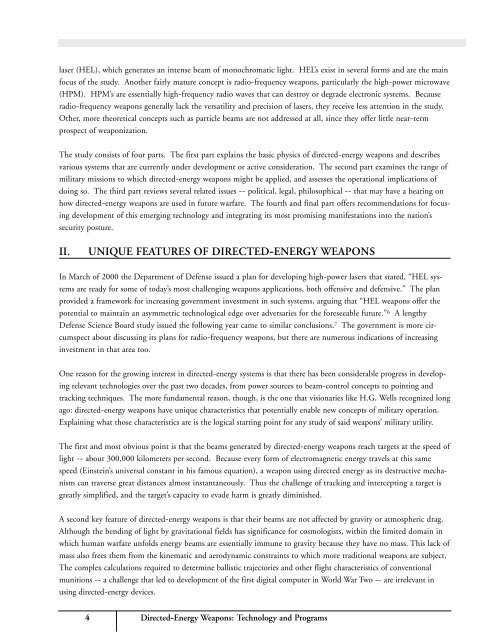directed-energy-weapons
directed-energy-weapons
directed-energy-weapons
Create successful ePaper yourself
Turn your PDF publications into a flip-book with our unique Google optimized e-Paper software.
laser (HEL), which generates an intense beam of monochromatic light. HEL’s exist in several forms and are the mainfocus of the study. Another fairly mature concept is radio-frequency <strong>weapons</strong>, particularly the high-power microwave(HPM). HPM’s are essentially high-frequency radio waves that can destroy or degrade electronic systems. Becauseradio-frequency <strong>weapons</strong> generally lack the versatility and precision of lasers, they receive less attention in the study.Other, more theoretical concepts such as particle beams are not addressed at all, since they offer little near-termprospect of weaponization.The study consists of four parts. The first part explains the basic physics of <strong>directed</strong>-<strong>energy</strong> <strong>weapons</strong> and describesvarious systems that are currently under development or active consideration. The second part examines the range ofmilitary missions to which <strong>directed</strong>-<strong>energy</strong> <strong>weapons</strong> might be applied, and assesses the operational implications ofdoing so. The third part reviews several related issues -- political, legal, philosophical -- that may have a bearing onhow <strong>directed</strong>-<strong>energy</strong> <strong>weapons</strong> are used in future warfare. The fourth and final part offers recommendations for focusingdevelopment of this emerging technology and integrating its most promising manifestations into the nation’ssecurity posture.II.UNIQUE FEATURES OF DIRECTED-ENERGY WEAPONSIn March of 2000 the Department of Defense issued a plan for developing high-power lasers that stated, “HEL systemsare ready for some of today’s most challenging <strong>weapons</strong> applications, both offensive and defensive.” The planprovided a framework for increasing government investment in such systems, arguing that “HEL <strong>weapons</strong> offer thepotential to maintain an asymmetric technological edge over adversaries for the foreseeable future.” 6 A lengthyDefense Science Board study issued the following year came to similar conclusions. 7 The government is more circumspectabout discussing its plans for radio-frequency <strong>weapons</strong>, but there are numerous indications of increasinginvestment in that area too.One reason for the growing interest in <strong>directed</strong>-<strong>energy</strong> systems is that there has been considerable progress in developingrelevant technologies over the past two decades, from power sources to beam-control concepts to pointing andtracking techniques. The more fundamental reason, though, is the one that visionaries like H.G. Wells recognized longago: <strong>directed</strong>-<strong>energy</strong> <strong>weapons</strong> have unique characteristics that potentially enable new concepts of military operation.Explaining what those characteristics are is the logical starting point for any study of said <strong>weapons</strong>’ military utility.The first and most obvious point is that the beams generated by <strong>directed</strong>-<strong>energy</strong> <strong>weapons</strong> reach targets at the speed oflight -- about 300,000 kilometers per second. Because every form of electromagnetic <strong>energy</strong> travels at this samespeed (Einstein’s universal constant in his famous equation), a weapon using <strong>directed</strong> <strong>energy</strong> as its destructive mechanismcan traverse great distances almost instantaneously. Thus the challenge of tracking and intercepting a target isgreatly simplified, and the target’s capacity to evade harm is greatly diminished.A second key feature of <strong>directed</strong>-<strong>energy</strong> <strong>weapons</strong> is that their beams are not affected by gravity or atmospheric drag.Although the bending of light by gravitational fields has significance for cosmologists, within the limited domain inwhich human warfare unfolds <strong>energy</strong> beams are essentially immune to gravity because they have no mass. This lack ofmass also frees them from the kinematic and aerodynamic constraints to which more traditional <strong>weapons</strong> are subject.The complex calculations required to determine ballistic trajectories and other flight characteristics of conventionalmunitions -- a challenge that led to development of the first digital computer in World War Two -- are irrelevant inusing <strong>directed</strong>-<strong>energy</strong> devices.4 Directed-Energy Weapons: Technology and Programs


